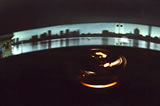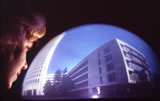| michael naimark |
|
|
|
Environmental Media Studies |
|
|
Environmental Media Studies explored new ways of representing landscape and place. Moving Movie #1 (1977) was an inexpensive modest study made
at MIT. I was obsessed with why movie cameras move and movie projectors
don’t, and filmed the Boston landscape with a Super8 movie
camera mounted on a slowly rotating turntable. The film is projected
using a continuous loop projector mounted on the same slowly rotating
turntable, using a translucent cylindrical screen so one can see
on both sides. The result is a very natural looking "flashlight
effect," with the frame rotating around the screen in sync
with the filmed material. As the projected image rotates around
the screen, direction and spatiality is maintained. |
|
|
|
|

